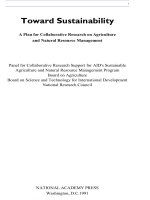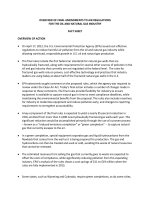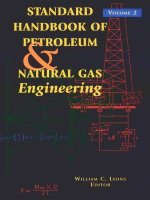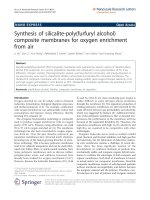Polymeric based membranes for hydrogen enrichment and natural gas sweetening
Bạn đang xem bản rút gọn của tài liệu. Xem và tải ngay bản đầy đủ của tài liệu tại đây (4.78 MB, 309 trang )
POLYMERIC-BASED MEMBRANES FOR HYDROGEN
ENRICHMENT AND NATURAL GAS SWEETENING
LOW BEE TING
NATIONAL UNIVERSITY OF SINGAPORE
2009
POLYMERIC-BASED MEMBRANES FOR HYDROGEN
ENRICHMENT AND NATURAL GAS SWEETENING
LOW BEE TING
(B.Eng., National University of Singapore, Singapore)
A THESIS SUBMITTED
FOR THE DEGREE OF DOCTOR OF PHILOSOPHY
DEPARTMENT OF CHEMICAL AND BIOMOLECULAR
ENGINEERING
NATIONAL UNIVERSITY OF SINGAPORE
2009
i
ACKNOWLEDGEMENTS
The journey to the accomplishment of a PhD degree is certainly full of challenges. As my
time as a graduate student draws to a close, I would like to acknowledge the people who
made this endeavor a wonderful and rewarding experience. First and foremost, I wish to
thank my family and friends for their constant support and love throughout my
candidature. My academic advisor, Professor Chung Tai-Shung, Neal is an enthusiastic
membrane scientist who has bestowed numerous opportunities and well-equipped
research facilities for me to excel in my research playground. Over the past three years,
he has pushed me to achievements beyond what I ever imagine and nurtured me as an
independent researcher. I wish to express my sincere appreciation to Professor Chung for
his teaching and guidance.
My mentor, Dr. Xiao Youchang has been a constant source of advice, inspiration and
encouragement. He is an exceptionally creative and intelligent researcher, without whom
a significant portion of the work described herein may have been unattainable. It is indeed
a true blessing to have the opportunity to work with him. Thanks are given to my buddy,
Dr. Widjojo Natalia who has guided me in my research from the first day I embarked on
this tough research expedition. She has showered me with love and joy, and has made my
life as a graduate student colorful and enjoyable. Thank you both for always being there
for me and for telling me what I need to hear and not what I want to hear at the critical
moments.
ii
I would like to convey my appreciation to Dr. Shao Lu and Dr Wang Kaiyu for their
valuable advice to my work, and for sharing their knowledge and technical expertise with
me. Special thanks are dedicated to Professor Donald R. Paul from the University of
Texas at Austin and Professor Maria R. Coleman from the University of Toledo for their
professional and constructive suggestions. My gratitude extends to Ms Chng Mei Lin for
her helpful assistance in the daily operations of my experiments and for being a great
friend. Thanks are due to the fun-loving members of Professor Chung’s group, the
resourceful and helpful laboratory technologists and all who have assisted me in one way
or another.
I gratefully acknowledge the research scholarship by the National University of
Singapore. I would like to thank the Singapore National Research Foundation (NRF) for
the support on the Competitive Research Programme for the project "Molecular
Engineering of Membrane Materials: Research and Technology for Energy Development
of Hydrogen, Natural Gas and Syngas" (grant number R-279-000-261-281) and A*Star
support for the project “Polymeric Membrane Development for CO
2
Capture from Flue
Gas” (grant number R-398-000-058-305).
iii
TABLE OF CONTENTS
ACKNOWLEDGEMENT…………………………………………………………………i
TABLE OF CONTENTS…………………………………………………………………iii
SUMMARY…………………………………………………………………………… x
NOMENCLATURE…………………………………………………………………… xv
LIST OF TABLES……………………………………………………………………….xix
LIST OF FIGURES………………………………………………………………….… xxi
CHAPTER 1 INTRODUCTION…… ………………………………………………… 1
1.1. The quest for clean fuels to curb global warming and the energy crisis… …… 2
1.2. Membrane technology as an emerging tool for gas purification………………….5
1.3. Diversity of membrane materials…………………………………………………7
1.3.1 Polymers………………………………………………………………… 7
1.3.2 Inorganics (metallic and non-metallic)…………………………… ……10
1.3.3 Organic-inorganic hybrids……………………………………………… 12
1.4. Gas transport mechanisms………… ………………………………………… 13
1.4.1 Solution diffusion……………….…………………………………… 13
1.4.2 Poiseuille flow, Knudsen diffusion and molecular sieving 16
1.5. Membrane fabrication and structures…………….……………….…………… 18
1.6. Types of membrane module configurations…………… ………………………22
1.7. Process and cost optimization ………………… ……… ………… ……… 23
1.8. Research objectives and organization of dissertation………………………… 25
iv
1.9. References……………………………………………………………………….28
CHAPTER 2 LITERATURE REVIEW………………………………………………….36
2.1. Membrane material design guidelines for hydrogen and natural gas
purifications………………………………………………………… …….… 37
2.2. Molecular design of polymers………………………………………………… 39
2.2.1 Homopolymer and random copolymer………………………………… 39
2.2.2 Block copolymer with hard and soft segments………………………… 45
2.3. Polymer blends………………………………………………………………… 47
2.3.1 Linear polymer blends……………………………………………………47
2.3.2 Interpenetrating polymer networks………………………………………50
2.4. Chemical modification………………………………………………………… 52
2.4.1 Diamine crosslinking of polyimide………………………………………52
2.4.2 Diol crosslinking of polyimide containing carboxylic acid groups…… 55
2.4.3 Rubbery polymers with crosslinked networks………………………… 57
2.4.4 Halogenation, sulfonation and metal ion-exchange………… ……….59
2.5. Mixed matrix membranes……………………………………………………….63
2.6. Challenges and future prospects……………………………………………… 66
2.7. References……………………………………………………………………….68
CHAPTER 3 THEORETICAL BACKGROUND……………………………………….81
3.1. Theory of gas transport in dense glassy polymeric membranes……………… 82
v
3.1.1 Concept of polymer free volume…………… … ………………………82
3.1.2 Sorption in glassy polymers…… ………………………………………85
3.1.3 Diffusion in glassy polymers… …………………………………………87
3.2. Plasticization by condensable gases and vapors……………………………… 90
3.3. Physical aging phenomenon…………………………………………………… 93
3.4. Robeson upper bound relationships…………………………… …………… 97
3.5. References……………… …………………………………………………… 99
CHAPTER 4 METHODOLOGY……………………………………………………….107
4.1. Materials……………………………………………………………………… 108
4.1.1 Polymers……………………………………………………………… 108
4.1.2 Modification and crosslinking reagents…………… ……………… 110
4.2. Membrane fabrication and modification protocols ….…………………… 111
4.2.1 Polyimide dense films………………………………………………… 111
4.2.2 Polyimide/azide pseudo interpenetrating networks…………………… 111
4.2.3 Polyimide/polyethersulfone dual-layer hollow fiber membranes………112
4.2.3.1 Dope preparation……………………………………………………112
4.2.3.2 Spinning conditions and solvent exchange………………………….115
4.2.4 Diamine modification……….………………………………………… 118
4.3. Membrane characterization……….…………………………… …………….119
4.3.1 Fourier transform infrared spectroscopy (FTIR)……………………… 119
4.3.2 X-ray photoelectron spectroscopy (XPS)……………………………….120
4.3.3 Ultraviolet-visible light spectroscopy (UV-Vis)…………………… 120
vi
4.3.4 Gel permeation chromatography (GPC)……………………………… 120
4.3.5 Gel content analysis…………………………………………………… 121
4.3.6 Density test…………………………………………………………… 121
4.3.7 Contact angle measurement…………………………………………… 122
4.3.8 Thermal gravimetric analysis (TGA)………………………………… 122
4.3.9 Differential scanning calorimetry (DSC)…….…………………………122
4.3.10 Dynamic mechanical analysis (DMA)………………………………….123
4.3.11 Tensile measurement……………………………………………………123
4.3.12 Nanoindentation……………………………………………………… 124
4.3.13 Wide angle x-ray diffraction (WAXRD)…………………………… …124
4.3.14 Positron annihilation lifetime spectroscopy (PALS)……………………125
4.3.15 Atomic force microscopy (AFM)……………………………………….126
4.3.16 Field emission scanning electron microscopy (FESEM)……………….126
4.4. Molecular simulation.……………… …………………………… …………126
4.4.1 Molecular dimensions and nucleophilicity of diamines……………… 126
4.4.2 Polyimide free volume and mean square displacements……………… 127
4.5. Determination of gas transport properties…………………………………… 129
4.5.1 Constant volume-variable pressure gas permeation chamber………… 129
4.5.2 Pure gas permeation…………………………………………………….130
4.5.3 Mixed gas permeation………………………………………………… 132
4.5.4 Pure gas sorption……………………………………………………… 135
4.6. References…………………………………………………………………… 136
vii
CHAPTER 5 EFFECT OF DIAMINE PROPERTIES AND MODIFICATION
DURATION ON THE H
2
/CO
2
SEPARATION PERFORMANCE OF DIAMINE-
MODIFIED POLYIMIDE MEMBRANES…………………………………………….138
5.1. Introduction…………………………………… 139
5.2. Results and Discussion…………………………………………………………144
5.2.1 Characterization of the modified films………………………………….144
5.2.2 Gas separation properties of modified copolyimide films…………… 158
5.3. Conclusions…………………………………………………………………….170
5.4. References…………………………………………………………………… 171
CHAPTER 6 INFLUENCE OF POLYIMIMDE INTRINSIC FREE VOLUME AND
CHAIN RIGIDITY ON THE EFFECTIVENESS OF DIAMINE MODIFICATION….177
6.1. Introduction…………………………………… 178
6.2. Results and Discussion…………………………………………………………183
6.2.1 Characterization …………………… ………………………………….183
6.2.2 Molecular simulation ………………………………………………… 189
6.2.3 Gas separation properties ……………………………….…………… 191
6.3. Conclusions…………………………………………………………………….201
6.4. References…………………………………………………………………… 201
CHAPTER 7 DIAMINE MODIFICATION OF POLYIMIDE/POLYETHERSULFONE
DUAL LAYER HOLLOW FIBER MEMBRANES FOR HYDROGEN
viii
ENRICHMENT…………………………………………………………………………209
7.1. Introduction…………………………………… 210
7.2. Results and Discussion…………………………………………………………214
7.2.1 Morphology of the dual-layer hollow fiber membranes ……………….214
7.2.2 Influence of air gap on gas transport properties… ……………………216
7.2.3 Effect of 1,3-diaminopropane modification on H
2
/CO
2
transport properties
…………………………………………………….…………… 222
7.3. Conclusions……………… …………………………….…………………….230
7.4. References…………………………………………………………………… 231
CHAPTER 8 MEMBRANES COMPRISING OF PSEUDO-INTERPENETRATING
POLYMER NETWORKS (IPN) FOR CO
2
/CH
4
SEPARATION…………….…… …236
8.1. Introduction…………………………………… 237
8.2. Results and Discussion…………………………………………………………242
8.2.1 Chemical reactions of 2,6-bis(4-azidobenzylidene)-4-methylcyclohexanone
………………………………………………………………………… 242
8.2.2 Validation of the formation of a pseudo-IPN and interconnected pseudo-
IPN………………………………………………………………………247
8.2.3 Physical properties of the pseudo IPNs…………………………………250
8.2.4 Gas transport properties and potential application in membrane gas
separation……………………………………………………………… 258
8.3. Conclusions……………… …………………………….…………………….265
8.4. References…………………………………………………………………… 267
ix
CHAPTER 9 CONCLUSIONS AND RECOMMENDATIONS……………………….274
9.1 Conclusions……………… …………………………….…………………….275
9.1.1 A review of the research objectives of this work……………………….275
9.1.2 Diamine modification of polyimide dense membranes for H
2
/CO
2
separation……………………………………………………………… 276
9.1.3 Modification of 6FDA-NDA/PES dual layer hollow fiber membranes with
1,3-diaminopropane…………………………………………… 277
9.1.4 Pseudo-interpenetrating polymer network for CO
2
/CH
4
separation……278
9.2 Recommendations…………………………………………………………… 279
9.2.1 Motivation………………………………………………………………279
9.2.2 Effect of grafting different functional groups on polyimide
membranes………………………………………………………………280
9.2.3 Polyimide/POSS
®
hybrid membranes for CO
2
/CH
4
separation……… 280
9.2.4 Effect of the sulfonation degree on the gas separation performance of
poly(ether ether ketone)……………………………………………… 281
9.2.5 CO
2
-selective polymers based on poly(ethylene oxide) units………… 282
x
SUMMARY
The volatile and escalating oil prices, combined with concerns about the environmental
consequences of anthropogenic carbon dioxide emissions, have led to the growing interest
in the development of alternative energy sources. The world energy consumption
continues to be at the core of the climate change debate and the use of natural gas and
hydrogen is recommended to alleviate global warming. Membrane technology is a
promising purification technique for hydrogen enrichment and natural gas sweetening.
Polymeric membranes remain the most viable commercial choice and substantial research
works on the design of polymers with improved gas separation performance and
physicochemical properties are in progress. Various approaches have been utilized by
membrane scientists to overcome the bottlenecks and to achieve this goal.
Due to the undesirable coupling of high H
2
diffusivity and CO
2
solubility, it is an
exceptionally challenging task to separate H
2
and CO
2
by polymeric membranes. Majority
of the polymers display inferior H
2
/CO
2
selectivity and the current state of the art remains
inadequate for industrial applications. For CO
2
/CH
4
separation, polymers with good
CO
2
/CH
4
selectivity and CO
2
permeability are available. Hence,
greater emphasis must be
placed on strategies to suppress CO
2
-induced plasticization. In this study, the diamine
modification of polyimide dense membranes is investigated for enhancing the intrinsic
H
2
/CO
2
selectivity. The critical parameters that determine the effectiveness of the
modification approach are comprehensively examined. Commercially, asymmetric hollow
fiber membranes are of greater significance compared to dense films. Therefore, the
xi
fabrication of polyimide/polyethersulfone dual-layer hollow fiber membranes and the
post-treatment with an aliphatic diamine are studied for H
2
/CO
2
separation. A synthetic
approach that involves the in-situ preparation of a pseudo interpenetrating polymer
network (IPN) comprising of an azido-containing monomer and a polyimide is explored.
The CO
2
/CH
4
separation performance and the CO
2
-plasticization behavior of the pseudo-
IPNs are evaluated. The key results and conclusions obtained from this study are
presented as follows.
The surface modifications of copoly(4,4’-diphenyleneoxide/1,5-naphthalene-2,2’-bis(3,4-
dicarboxylphenyl) hexafluoropropane diimide (6FDA-ODA/NDA) dense membranes are
performed using aliphatic diamines of different spacer lengths i.e. ethylenediamine
(EDA), 1,3-diaminopropane (PDA) and 1,4-diaminobutane (BuDA). Chemical grafting,
crosslinking and polymer main chain scission occurs simultaneously on the film surface
during the modification. The extent of each reaction depends on the nucleophilicity and
molecular dimensions of the diamines, which are computed using molecular simulation.
The small molecular dimensions and high nucleophilicity of EDA result in severe
polymer main chain scission. PDA provides the greatest degree of cross-linking and this
is attributed to its favorable kinetic property and appropriate nucleophilicity. The ideal
H
2
/CO
2
permselectivity increases from 2.3 to a remarkable value of 64 after PDA
modification for 90 min. This promising result is re-confirmed by the binary gas tests
showing a H
2
/CO
2
permselectivity of 45 at 35 ºC. In a nutshell, appropriate selections of
the diamino reagent and modification duration are required to crosslink the polymer
xii
chains substantially while maintaining the main chain rigidity, thereby giving the desired
gas separation performance of the membrane.
The effectiveness of the diamine modification approach is also dependent on the inherent
properties of the polyimides. The integration of molecular design with diamine
modification generates synergistic effects for enhancing and fine tuning the molecular
sieving potential of polyimide membranes. Polymer free volume and rigidity represent
crucial conformational parameters that influence the effectiveness of diamine
modification for elevating the H
2
/CO
2
permselectivity of polyimide membranes.
Experimental and molecular dynamics simulation results suggest that polyimides with
higher intrinsic free volume and rigidity are ideal for diamine treatment, yielding greater
increment in H
2
/CO
2
selectivity. A series of 6FDA-ODA/NDA copolyimide membranes
are modified with PDA. 6FDA-NDA has the highest free volume and rigidity, thus
exhibiting impressive improvement in ideal H
2
/CO
2
selectivity from 1.8 to 120 after PDA
modification. Conversely, 6FDA-ODA which is deficient in terms of free volume and
rigidity, demonstrates a much lower increment in H
2
/CO
2
selectivity from 2.5 to 8.2. The
inherent heterogeneity of the PDA modified polyimide films results in thickness-
dependent gas permeability and selectivity. The potential of merging macromolecular
tailoring with diamine networking to enhance the H
2
/CO
2
separation performance of
polyimide membranes is evident.
In view of the promising H
2
/CO
2
separation performance of the PDA-modified dense
films, we have developed functional 6FDA-NDA/polyethersulfone (PES) dual layer
xiii
hollow fiber membranes and studied their performance for H
2
/CO
2
separation before and
after PDA modification. The effects of air gap on gas transport properties of as-spun
hollow fiber membranes are investigated. For the first time, we have observed that the
optimal air gap for maximizing the ideal permselectivity is strongly dependent on the
kinetic diameters of gas pair molecules. A higher air gap diminishes the population of
Knudsen pores in the apparently dense outer skin layer and induces greater elongational
stresses on polymer chains. The latter enhances polymer chain alignment and packing
which possibly result in the shift and sharpening of the free volume distribution. Due to
the influence of methanol swelling and the high initial diffusion rates of diamines, the
chemical modification occurs throughout the polyimide outer layer. This densifies
the
asymmetric structure of the pristine 6FDA-NDA outer layer and creates additional
resistance to gas transport, which hinders the enhancement in H
2
/CO
2
permselectivity that
can be reaped. At higher temperature, the H
2
permeance of the PDA-modified fibers
increases with negligible decrease in the H
2
/CO
2
permselectivity. The diamine
modification of 6FDA-NDA/PES dual layer hollow fiber membranes effectively
suppresses the CO
2
-induced plasticization.
In the last part of this study, a novel synthetic strategy to fine tune the cavity size and free
volume distribution of polyimide membranes via the formation of homogenous pseudo-
interpenetrating polymer networks (IPN) is explored. The transformation in the free
volume characteristics of the pseudo-IPN can be effectively exploited for achieving
enhanced gas transport properties. The molecular construction of the pseudo-IPNs entails
the in-situ polymerization of azido-containing monomers with multi-reactive sites within
xiv
rigid polyimide molecular scaffolds. The intrinsic free volume of the host polyimide and
the dimensions of the azido-containing monomer predominantly influence the mean
cavity size of the semi-IPN. The pseudo-IPNs assembled using fluorinated polyimides
and 2,6-bis(4-azidobenzylidene)-4-methylcyclohexanone (azide) display improved
CO
2
/CH
4
separation performance. The alterations in the gas permeability and gas pair
permselectivity of the semi-IPNs are adequately mapped to the variation in the free
volume distributions characterized by the positron annihilation lifetime spectroscopy.
Depending on the functionalities of the host polyimides, chemical cross-links are formed
between the azide network and the pre-formed linear polyimide. The chemical bridges in
conjunction with the interpenetrating network restrict the mobility of the polymer chains
and suppress CO
2
-induced plasticization.
In summary, polymeric membranes with enhanced H
2
/CO
2
selectivity via the diamine
modification of polyimides have been developed. The chemistry and key parameters for
optimizing of the diamine modification approach are identified and established. This
modification technique is demonstrated on asymmetric hollow fiber membranes which
are of greater commercial importance. In addition, polyimide/azide pseudo-
interpenetrating polymer networks with promising CO
2
/CH
4
separation performance and
enhanced anti-plasticization properties against CO
2
are discovered. The applicability of
polymeric membranes for hydrogen enrichment and natural gas sweetening are evident.
This motivates one to work towards the realization of membrane technology for clean
energy applications and recommendations for the future research directions are
highlighted.
xv
NOMENCLATURE
A Effective membrane area
A
d
Penetrant dependent parameter (Fujita FFV model)
A
*
Constant (Cohen and Turnbull model)
B
d
Penetrant dependent parameter (Fujita FFV model)
b Langmuir affinity constant
b
0
Pre-exponential factor for b
C Local penetrant concentration in the membrane
C
m
Material-dependent constant (0.001-0.003 for polymers)
C
D
Gas concentration at the Henry sites
C
H
Gas concentration at the Langmuir sites
C
H
’ Langmuir capacity constant
c Polymer dependent parameter (Brandt’s model)
D Diffusivity
D
D
Diffusion coefficient at the Henry sites
D
H
Diffusion coefficient at the Langmuir sites
D
app
Apparent diffusion coefficient
D
avg
Average diffusion coefficient
D
f
Self-diffusion coefficient
D
0
Pre-exponential factor for D
d Average d-spacing of polymer chains
d
k
Kinetic diameter
xvi
dp/dt Rate of pressure increase at steady state
E
D
Activation energy for diffusion
E
p
Activation energy for gas permeability
F Ratio of D
H
to D
D
f Polymer dependent parameter (Brandt’s model)
I
3
Intensity
k Boltzmann’s constant
K C
H
’b/k
D
k
D
Henry law constant
k
D0
Pre-exponential factor for k
D
L
T
Total membrane thickness
L
1
Thickness of modified layer
L
2
Thickness of unmodified layer
l Membrane thickness
M
W
Gas molecular weight
M
WA
Molecular weight of gas A
M
WB
Molecular weight of gas B
M
i
Polymer-penetrant interaction parameter
M
0
Original mass of the crosslinked film
M
1
Mass of the insoluble fraction of the crosslinked film
N Steady-state gas flux through the membrane
N
c
Constant 0.023 K
-
1
P Gas permeability
xvii
P
0
Pre-exponential factor for P
P
1
Gas permeability of modified layer
P
2
Gas permeability of unmodified layer
P/l Gas permeance
p Pressure
p
1
Downstream pressure
p
2
Upstream pressure
R Universal gas constant
r
3
Mean free-volume radius
S Solubility
T Temperature
T
c
Critical temperature
T
g
Glass transition temperature
V Downstream volume
V
W
Van der Waals volume
V
e
Equilibrium volume of polymer
V
sp
Specific volume of polymer
V
0
Occupied volume of polymer
v
f
Average free volume per molecule
v
f3
Mean free volume of a cavity
w
0
Mass of the sample in air
w
1
Mass of the sample in ethanol
x Gas molar fraction in the feed
xviii
y Gas molar fraction in the permeate
α
A/B
Permselectivity for component A relative to component B
α
K,A/B
Knudsen selectivity for gas A to gas B
β
AB
Parameter for the upper bound
γ Constant (Cohen and Turnbull model)
∆H
D
Sorption enthalpy for Henry sites
∆H
H
Sorption enthalpy for Langmuir sites
h Thickness of hollow fiber membrane
r An empirical constant (1.656 Å)
ε Potential energy well depth parameter
ε/k Lennard-Jones temperature
η Gas viscosity
θ Time lag
λ Mean free path of a gas molecule
λ
AB
Parameter for the upper bound
ρ Polymer density
ρ
ethanol
Density of ethanol
σ
c
Collision diameter
σ
eff
Effective diameter
τ
3
Parameter for determining the average cavity size in the polymer
ν
*
Minimum required volume of the void
xix
LIST OF TABLES
Table 1.1 Gas transport properties of commercial polymers used for fabricating gas
separation membranes………………………….………… ……………… 8
Table 2.1 Physical properties of H
2
, CO
2
and CH
4
……………………………………37
Table 4.1 Mass compositions of polyimide/azide casting solutions…………………112
Table 4.2 Spinning conditions……………………………………………………… 118
Table 5.1 Fukui indices, dimensions and pKa values of the aliphatic diamines…… 154
Table 5.2 Mechanical properties of the films with and without water sorption…… 156
Table 5.3 Gas permeation properties of pristine and diamine modified 6FDA-
ODA/NDA membranes at 35
o
C and 3.5 atm…………………………… 160
Table 5.4 H
2
/CO
2
separation performance of PDA modified 6FDA-durene and 6FDA-
ODA/NDA dense membranes at 35
o
C and 3.5 atm………………………170
Table 6.1 Physical properties of H
2
and CO
2
……………………………………… 181
Table 6.2 Elemental composition of polyimide membrane surface before and after PDA
modification determined by XPS………………………………………….185
Table 6.3 Gel content of PDA modified polyimide films………………………… 186
Table 6.4 Extent of PDA penetration during the modification of polyimide films….187
Table 6.5 Mechanical properties of pristine and PDA-modified homopolyimides….189
Table 6.6 Simulated FFV of copolyimides………………………………………… 190
Table 6.7 H
2
and CO
2
transport properties of pristine and PDA-modified copolyimide
films……………………………………………………………………….192
Table 6.8 H
2
and CO
2
transport properties of methanol-swelled polyimide films… 194
xx
Table 6.9 H
2
and CO
2
transport properties of PDA modified 6FDA-ODA/NDA (50:50)
films with different thickness…………………………………………… 199
Table 7.1 Effect of silicone rubber coating on the gas permeance………………… 219
Table 7.2 Effect of PDA modification duration on H
2
and CO
2
gas transport
properties………………………………………………………………… 222
Table 8.1 Thermal decomposition properties of 6FDA-polyimide/azide pseudo
IPNs……………………………………………………………………… 254
Table 8.2 Positronium lifetimes, intensities, mean free-volume radii and fractional free
volume for 6FDA-NDA/azide and 6FDA-TMPDA/azide films………….257
Table 8.3 Pure gas permeability of 6FDA-NDA/azide and 6FDA-TMPDA/azide films
tested at 35
o
C and 10 atm (unless otherwise stated)…………………… 259
Table 8.4 Ideal gas pair permselectivity of 6FDA-NDA/azide and 6FDA-TMPDA/
azide films…………………………………………………………………260
Table 8.5 CO
2
/CH
4
separation performance obtained from binary gas tests at 35
o
C………………………………………………………………………….263
xxi
LIST OF FIGURES
Figure 1.1 (a) World marketed energy use by fuel type and (b) world oil prices from
year 1890 to 2030 ………………………………………………………… 2
Figure 1.2 Different gas transport routes through hybrid polymeric membranes …… 12
Figure 1.3 Solution diffusion mechanism for a H
2
-selective polymeric membrane… 14
Figure 1.4 Schematics of (a) Poiseuille flow, (b) Knudsen diffusion and (c) molecular
sieving………………………………………………………………………17
Figure 1.5 Types of membrane structures…………………………………………… 19
Figure 1.6 (a) Hollow fiber and (b) spiral wound membrane modules ……………… 22
Figure 1.7 Coupling of membrane reaction with cryogenic distillation for N
2
/CH
4
separation………………………………………………………………… 24
Figure 1.8 Use of counter-current flow hollow fiber membrane module to reduce
methane loss during natural gas dehydration ………………………………24
Figure 2.1 H
2
/CO
2
separation performance of tailored polyimides……………………41
Figure 2.2 CO
2
/CH
4
separation performance of tailored polyimides………………… 42
Figure 2.3 Synthetic strategy for copolymer systems with soft and hard segments… 46
Figure 3.1 Specific volume of a polymer as a function of temperature……………… 82
Figure 3.2 Motion of gas molecules within cavities via a series of diffusional jumps 83
Figure 3.3 Time lag approach for determining apparent diffusivity, D
app
…………… 88
Figure 3.4 Diffusion of free volume and lattice contraction………………………… 94
Figure 4.1 Chemical structures of 6FDA, TMPDA, ODA and NDA monomers…… 108
xxii
Figure 4.2 (a) General structure of a 6FDA-based polyimide and (b) chemical structure
of polyethersulfone (PES)…………………………………………………109
Figure 4.3 Chemical structures of (a) EDA, (b) PDA, (c) BuDA and (d) azide………110
Figure 4.4 Plot of viscosity vs. concentration for the 6FDA-NDA/NMP:THF (5:3)
system at 35
o
C…………………………………………………………….114
Figure 4.5 Phase diagram for 6FDA-NDA/(NMP:THF)/H
2
O system at 25
o
C………114
Figure 4.6 Schematic of a hollow fiber spinning line…………………………… … 116
Figure 4.7 (a) Side view and (b) cross sectional view of a dual-layer hollow fiber
spinneret………………………………………………………………… 116
Figure 4.8 (a) Cross sectional view and (b) outer surface of 6FDA-NDA outer layer (air
gap = 0.5 cm and spinneret temperature = 25
o
C)…………………………117
Figure 4.9 (a) Cross sectional view and (b) outer surface of 6FDA-NDA outer layer (air
gap = 0.5 cm and spinneret temperature = 50
o
C)…………………… … 118
Figure 4.10 Constant volume-variable pressure gas permeation chamber for testing flat
membranes (pure gas)…………………………………………………… 130
Figure 4.11 Constant volume-variable pressure gas permeation chamber for testing flat
membranes (mixed gas)………………………………………………… 133
Figure 4.12 Microbalance sorption cell……………………………………………… 136
Figure 5.1 FTIR spectra of EDA modified films at different immersion times………145
Figure 5.2 FTIR spectra of diamine modified films with immersion time of 60 min 146
Figure 5.3 Reaction mechanisms between the diamine and polyimide……… …….148
Figure 5.4 UV-Vis spectra of (a) EDA, (b) PDA and (c) BuDA in methanol solutions
after modification………………………………………………………….151
xxiii
Figure 5.5 AFM images of 6FDA-ODA/NDA dense films modified using (a) EDA, (b)
PDA and (c) BuDA for an immersion time of 60 min…………………….152
Figure 5.6 Molecular simulation showing the electron density surrounding the
nucleophilic sites of a PDA molecule…………………………………… 153
Figure 5.7 Effects of modification on inter-segmental spacing of polyimide films… 158
Figure 5.8 CO
2
sorption isotherms of unmodified and modified dense films……… 161
Figure 5.9 H
2
/CO
2
separation performance of (a) EDA, (b) PDA and (c) BuDA
modified 6FDA-ODA/NDA films compared to the trade-off line……… 162
Figure 5.10 Schematic of a diamine modified polyimide film (simplified)…….…… 163
Figure 5.11 Gas separation performance of the 90 min PDA crosslinked membrane 165
Figure 6.1 Robeson plot of molecularly designed polyimide membranes……………179
Figure 6.2 FTIR spectra of (a) unmodified and (b) PDA-modified 6FDA-ODA/NDA
dense membranes………………………………………………………….184
Figure 6.3 Simplified resistance model for the PDA modified film………………….186
Figure 6.4 WAXD spectra of (a) unmodified and (b) PDA-modified 6FDA-ODA/NDA
films…………………………………………………………………… 188
Figure 6.5 (a) Simulated amorphous cell containing 6FDA-NDA homopolyimide chains
and (b) Occupied and free volume of the amorphous cell (grey: Van der
Waals surface; blue: Connolly surface with probe radius of 1.49 Å)…… 190
Figure 6.6 Simulated mean square displacements of 6FDA-ODA/NDA copolyimide
series………………………………………………………………………191
Figure 6.7 Effect of PDA crosslinking on the mean square displacements of 6FDA-
NDA polyimide chains…………………………………………………….196









